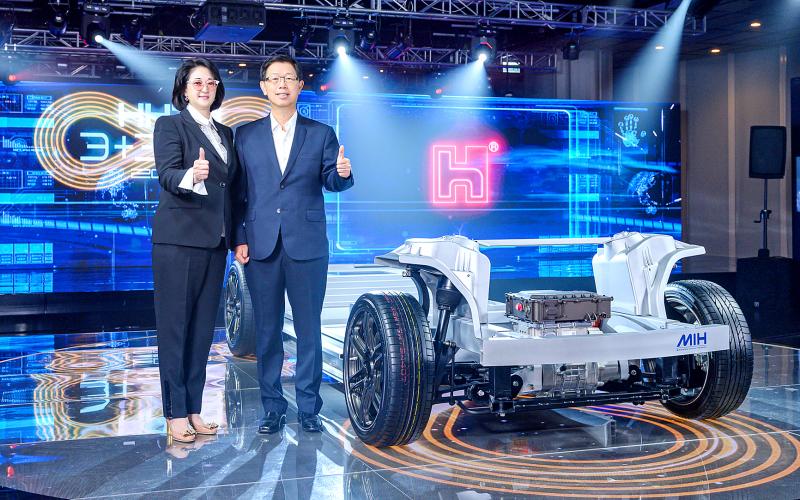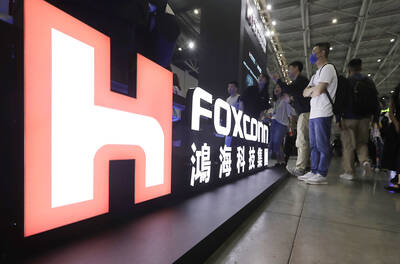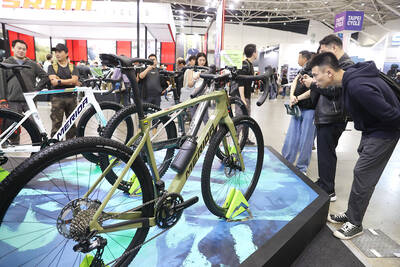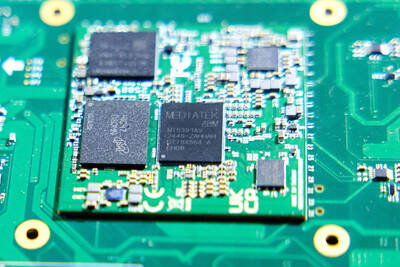Hon Hai Precision Industry Co (鴻海精密) said it aims to secure a 10 percent share of the world’s electric vehicle market by 2025, with about 3 million vehicles potentially using its platform.
The electronics giant yesterday unveiled the plan to expand its nascent automobile business, saying that it seeks to offset slowing growth in its core consumer electronics assembly business.
The company also outlined plans to release a solid-state battery by 2024 that could potentially displace the more commonly used lithium-ion batteries in electric vehicles.

Photo: CNA
Hon Hai plans to achieve its ambitious target by making its software and hardware platforms “open,” Hon Hai chairman Young Liu (劉揚偉) said during the company’s first “Foxconn Technology Day” in Taipei.
Liu, who in July last year took over from Hon Hai founder Terry Gou, has turned to the emerging automotive, robotics and medical applications sectors to boost profitability amid plateauing growth in smartphone units in the past few years.
“With our open platform, we will share the results of our development with everybody. It is to be owned by everybody, to be improved upon by everybody. This includes the open software platform and the open undercarriage platform,” Liu said. “This will cut down on repeat investment and make the Taiwanese electric vehicle supply chain more competitive and faster to market.”
The first vehicle using the open platform would enter the market in two years, and up to 10 percent of the world’s electric vehicles would be developed on the platform by 2025 to 2027, Liu said.
Hon Hai chief technology officer William Wei (魏國張) said that the company’s open software platform would make their vehicles “software defined” cars.
“The traditional car depreciates as soon as you drive it off the lot, but a software-defined car can be upgraded by software updates,” Wei said. “In a closed system, you cannot have collaboration. Through our open platform, we can work together and shorten the development cycle. This lowers the entry barrier for developers.”
“Sector insider Paul Graham said that Tesla is the iPhone of electric vehicles, but there is no Android yet,” Wei said. “We plan to be the Android.”
Hon Hai’s development partners include Taiwan’s Yulon Motor Co (裕隆汽車) and Fiat Chrysler Automobiles NV.
Hon Hai chief product officer Jerry Hsiao (蕭才祐) said the reason for Hon Hai’s confidence is that it controls key technologies for batteries and other vital components.
“Why Hon Hai? It is because we have the advantage in key components,” Hsiao said, adding that solid-state batteries and battery management through artificial intelligence would give Hon Hai the edge.
“The battery accounts for up to 35 percent of the cost of the vehicle,” Hsiao said. “Hon Hai will release the first commercial solid state battery in 2024.”
Smart battery management would improve battery performance, Hsiao said, adding that Hon Hai’s batteries “can even improve with time.”
The company’s self-driving technology is already being used in some airport shuttles in Japan, the company said.
Hon Hai last year generated almost NT$9.5 billion (US$327.82 million) in sales from automotive components.
The company is hoping that automotive and other new business branches can help boost its gross margin to 10 percent by 2025.

On Ireland’s blustery western seaboard, researchers are gleefully flying giant kites — not for fun, but in the hope of generating renewable electricity and sparking a “revolution” in wind energy. “We use a kite to capture the wind and a generator at the bottom of it that captures the power,” said Padraic Doherty of Kitepower, the Dutch firm behind the venture. At its test site in operation since September 2023 near the small town of Bangor Erris, the team transports the vast 60-square-meter kite from a hangar across the lunar-like bogland to a generator. The kite is then attached by a

Foxconn Technology Co (鴻準精密), a metal casing supplier owned by Hon Hai Precision Industry Co (鴻海精密), yesterday announced plans to invest US$1 billion in the US over the next decade as part of its business transformation strategy. The Apple Inc supplier said in a statement that its board approved the investment on Thursday, as part of a transformation strategy focused on precision mold development, smart manufacturing, robotics and advanced automation. The strategy would have a strong emphasis on artificial intelligence (AI), the company added. The company said it aims to build a flexible, intelligent production ecosystem to boost competitiveness and sustainability. Foxconn

Leading Taiwanese bicycle brands Giant Manufacturing Co (巨大機械) and Merida Industry Co (美利達工業) on Sunday said that they have adopted measures to mitigate the impact of the tariff policies of US President Donald Trump’s administration. The US announced at the beginning of this month that it would impose a 20 percent tariff on imported goods made in Taiwan, effective on Thursday last week. The tariff would be added to other pre-existing most-favored-nation duties and industry-specific trade remedy levy, which would bring the overall tariff on Taiwan-made bicycles to between 25.5 percent and 31 percent. However, Giant did not seem too perturbed by the

TARIFF CONCERNS: Semiconductor suppliers are tempering expectations for the traditionally strong third quarter, citing US tariff uncertainty and a stronger NT dollar Several Taiwanese semiconductor suppliers are taking a cautious view of the third quarter — typically a peak season for the industry — citing uncertainty over US tariffs and the stronger New Taiwan dollar. Smartphone chip designer MediaTek Inc (聯發科技) said that customers accelerated orders in the first half of the year to avoid potential tariffs threatened by US President Donald Trump’s administration. As a result, it anticipates weaker-than-usual peak-season demand in the third quarter. The US tariff plan, announced on April 2, initially proposed a 32 percent duty on Taiwanese goods. Its implementation was postponed by 90 days to July 9, then